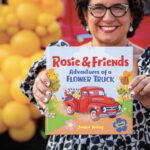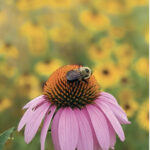Burg in Focus: Cooking with Qui from GK Visual on Vimeo.
When TheBurg suggested I get together and cook with Qui Qui Musarra, chef/owner of three premier Harrisburg restaurants (Mangia Qui, Suba and Rubicon), I had a few moments of apprehension.
I knew she was extraordinarily busy. And while food is my passion and favorite “pastime,” I am a home cook. I read cookbooks like novels and try to learn as much as I can about Italian food, the cuisine of my heritage. But I am an amateur. I couldn’t imagine Qui would want to make time for something like this, or even had the time.
But, after speaking with her one evening at Rubicon, I sensed she was eager to do it. And, for me, I knew it would be a wonderful adventure and that the resulting column would be a unique addition to the annual food issue of TheBurg.
I was honored for the opportunity to cook with Qui. So, we discussed possible dishes and decided on one that would celebrate spring and all of its bright green vegetables that are with us so briefly. I told her I’d always wanted to cook with fresh fava beans, a broad bean popular in Italian cooking, but have never been able to find them. I also love artichokes and freshly shelled peas and suggested that we might use them, too.
Qui suggested a dish called Roman vignarola, which is a mix of spring vegetables cooked together into a savory stew that can be a meal in itself. In Rome, locally grown artichokes serve as stars of this dish, but I learned that many other combinations of vegetables can be used according to personal preference and availability. We included little Yukon Gold potatoes, which I love, and that added more substance to the dish.
I was a little nervous putting my cooking skills on display, but Qui very kindly gave me some pointers on slicing and chopping and grasping a sharp knife properly. She showed me how to use a mandolin, which is used for making thin and uniform vegetable slices (only one close-to-finger-slicing encounter!). I had many questions for Qui as we began to put the vignarola together:
- How do you shell fresh fava beans? (The outer pods and inner skins must be removed.)
- Can you substitute baby lima beans if fresh favas are unavailable? (Yes, as favas are hard for the home cook to find.)
- What kind of onions should be used, and what is the easiest way to slice them? (Qui used yellow cooking onions, while I usually cook with Vidalia or another sweet onion.)
- Do you use any special olive oil? (She used regular extra virgin.)
- What type of sauté pan are you using? (Qui used an aluminum skillet but any good, heavy piece of cookware will do.)
- Is a mandolin necessary to slice the little potatoes? (Regular slicing with a sharp knife is fine.)
- Why do you add water to cook the potatoes instead of just olive oil? (The potatoes absorb the water and oil mixture to become creamy and soft.)
Since we didn’t have artichokes to accompany the potatoes that day, we used fava beans, fresh pod peas, yellow cooking onions, garlic, sliced Italian green beans (my mother called them Roma beans), and lots of chopped fresh herbs. We didn’t measure our ingredients but, in the directions below, I have tried to approximate the amounts we used.
Ingredients
- 2 medium, yellow cooking onions, cut in half and then sliced into half-moons
- 1 pound of small Yukon Gold potatoes, unpeeled, and cut into thin slices (either by hand or by using a mandolin)
- Several fresh garlic cloves, peeled and minced
- 1 cup of water and about ¾ cup extra virgin olive oil (or more if needed)
- About 2 cups shelled, fresh fava beans or frozen baby lima beans
- 1 to 2 cups of shelled fresh pod peas
- 1 cup of fresh Italian green beans, sliced into 1-inch pieces
- Fresh oregano and chives, chopped
- Freshly grated Parmesan Reggiano cheese
- Salt and pepper to taste
Directions
- Gently sauté the onions and garlic in the olive oil until softened and golden in color.
- Add the sliced potatoes, additional olive oil, water, salt and pepper and cook over medium-low heat until the potatoes are tender.
- Add the fava beans, Roma beans and peas, and cook gently until tender and most of the liquid has evaporated. (Do not cover the pan or the vegetables will lose their bright green color.)
- Mound the vignarola on an oval platter and shower it with a handful of chopped oregano and chives and freshly grated Parmesan. (Dried herbs will not do!)
Our finished dish was wonderful. Topped with some edible flowers, it seemed like a real celebration of spring (I kept sneaking little spoonfuls hoping no one would notice). How lovely it would be to serve vignarola for a simple lunch with some crusty bread and a cold white wine. It could be part of dinner, too, along with grilled chicken or pan-fried flounder or sole. Qui told us vignarola may soon be making an appearance at one of her restaurants paired with some tender spring lamb.
As my special afternoon with Qui at Rubicon came to an end, I studied the beautiful still life she had set up for TheBurg photographers: the platter of vignarola, a big wedge of Parmesan, a sauce boat of green olive oil, a cheese grater that resembled a witch’s hat and several of the raw ingredients we had used.
The afternoon sun was streaming through the front windows of the lovely bistro that is Rubicon, and I thought how lucky our little city is to have this talented and unique chef in Qui Qui Musarra. Our editor at TheBurg, Larry Binda, once wrote that Harrisburg “needs to do small city well.” Qui certainly does, but I think she could do big city, too.
Author: Rosemary Ruggieri Baer






